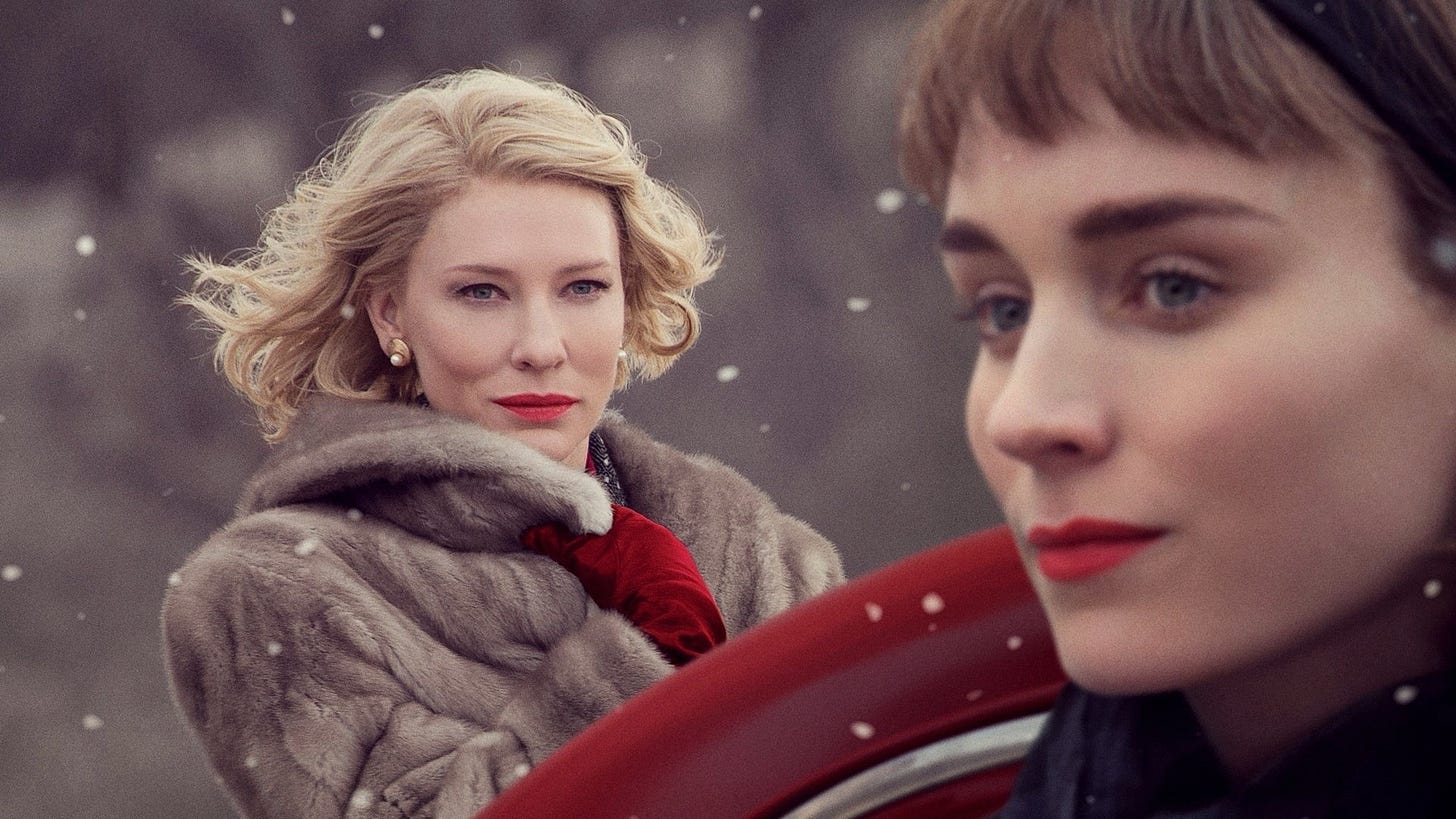Before I ever read The Price of Salt, I watched it unfold on the big screen as Carol. I didn’t know it was based on a novel. I didn’t know it was groundbreaking. I just knew I was captivated.
It was a dark and blustery January evening in 2016—my twenty-sixth birthday, to be exact. I decided to do something outlandish and take myself to a movie I’d been dying to see. Cate Blanchett and Rooney Mara were playing lovers in a glossy 1950s drama. But even in midtown Manhattan, it was surprisingly hard to find a theater showing it.
(Same-sex marriage had only been legalized in the U.S. about six months earlier, and Carol wouldn’t go into wide release until the following week.)
Sitting there with my popcorn, soda, and Sour Patch Kids, I wasn’t prepared for the way the story would linger—or the way it would reshape how I thought about queer representation in books, especially those written decades before I was born.
Carol (or The Price of Salt) is a love story set in 1950s New York. Therese, a young woman working in a department store, meets Carol, an older, sophisticated housewife caught in a bitter divorce. As their bond deepens, so do the risks they face in a society that condemns their love.
But what made this semi-autobiographical novel so groundbreaking in 1952? In short, it was its more hopeful sapphic narrative.
(Which, now that I think of it, is probably why it resonated with 2016 audiences, too. There was a newfound hope that society would accept same-sex relationships more widely.)
Most queer characters in the late 19th and early 20th centuries were either coded—masked by harmful stereotypes or subtext—or portrayed tragically or criminally. Think the “confirmed bachelor” or effeminate man, the spinster with intense female friendships, or the vampiric undertones in the sapphic-coded horror Carmilla by Sheridan Le Fanu.
By the mid-century, censorship had taken an even firmer hold. The Comstock Laws and Hays Codes didn’t just impact what could be printed or shown in theatres; they helped enforce a cultural narrative that same-sex relationships were immoral, illegal, and dangerous. Books that dared to depict them risked being banned or destroyed for promoting immoral behavior.
Carol, though, with its openly sapphic storyline, emotional depth, and its unexpected ending subverted the publishing industry and society writ large. It’s no wonder Highsmith published the novel under a pseudonym (Claire Morgan) and at a small, niche publisher (Highland Press).
Therese’s sexual awakening, Carol’s guarded resilience, the stolen road trip, the claustrophobic holiday backdrop, all added up to something that felt dangerous and quietly triumphant. At a time when queerness was erased, punished, or pathologized, Carol simply allowed two women to fall in love.
It took some time for the book’s full impact to land. When I finished it, I wasn’t sure how I felt. It wasn’t an instant five-star read but it soon became one as its depth and nuance unfurled.
Neither Carol nor Therese is especially “likable,” but that’s what made them feel authentically human. Therese starts off naïve, aimless, swept up in Carol’s confidence and allure. By the end, she’s grown, not just in terms of her sexuality, but in her ability to stand on her own. Carol, for her part, can come across as domineering and even cold, but how else might someone behave in a world that repudiates their existence? Her sharper edge feels earned.
What makes Carol endure is its balance of yearning and restraint, its refusal to explain or justify itself. It’s not just a romance; it’s a portrait of women carving out space to live truthfully in a society that insists on denying them that right.
While its resonance with me is as a heterosexual woman, Carol has stayed with me because it is both deeply specific and surprisingly universal. It’s a story about queerness, yes, but also about identity, risk, and the longing to live truthfully, even when it comes at a cost.
Reading it with historical hindsight only deepens its impact. I may not share the lived experience of its characters, but I can recognize the courage it takes to reach for a fuller, more authentic life, and the power of seeing that desire taken seriously on the page.
Wishing you the company of a good book,
Brittany





